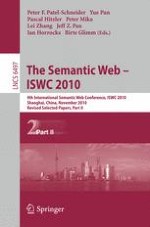The two-volume set LNCS 6496 and 6497 constitutes the refereed proceedings of the 9th International Semantic Web Conference, ISWC 2010, held in Shanghai, China, during November 7-11, 2010. Part I contains 51 papers out of 578 submissions to the research track. Part II contains 18 papers out of 66 submissions to the semantic Web in-use track, 6 papers out of 26 submissions to the doctoral consortium track, and also 4 invited talks. Each submitted paper were carefully reviewed. The International Semantic Web Conferences (ISWC) constitute the major international venue where the latest research results and technical innovations on all aspects of the Semantic Web are presented. ISWC brings together researchers, practitioners, and users from the areas of artificial intelligence, databases, social networks, distributed computing, Web engineering, information systems, natural language processing, soft computing, and human computer interaction to discuss the major challenges and proposed solutions, the success stories and failures, as well the visions that can advance research and drive innovation in the Semantic Web.
